Welcome to Madagascar! Finally, we got around to editing and sorting out the tons of material that we collected during our epic summer trip. Considering that it’s Halloween today, let’s start with famadihana, an exhumation ceremony. Let’s get ready to dance with the dead!

What is Famadihana?
In Madagascar, death is not forever. The dead enter the realm of the spirits. They live in trees, in animals, in the air. You shouldn’t point with your finger outstretched, we were told. You may offend the spirits floating about, between one world and another.
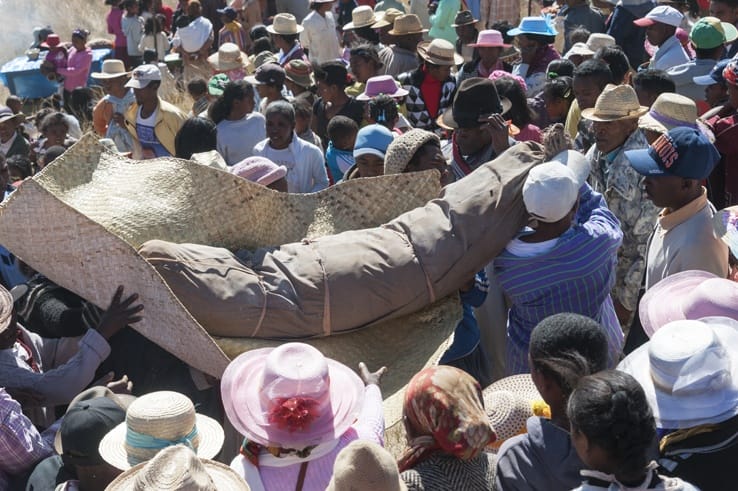
Death is not the end. The spirits want to return to Earth, every so often. Buried in family graves, the dead are cold and bored, and they miss their families. Every now and then, it’s time to return. The graves are opened and the dead, wrapped in shrouds, are laid out to rest, to bathe in the sun, while their families party and dance with them. This is famadihana, the turning of the bones.
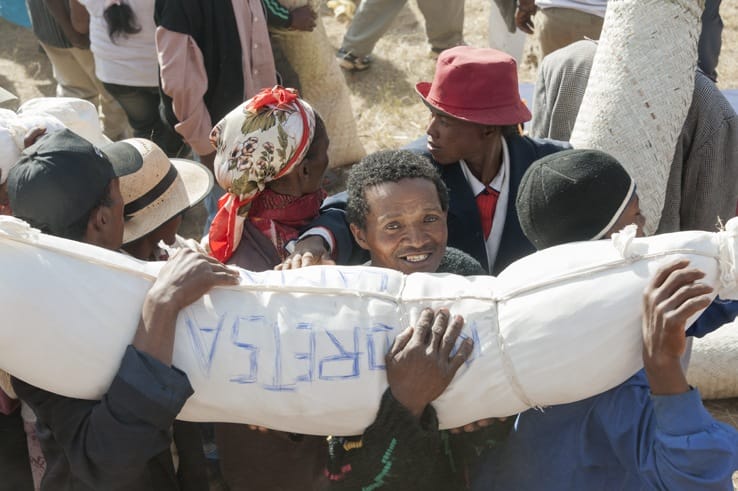
Visiting Famadihana
Famadihana takes place every year between the months of July and October, in the highlands of Madagascar, roughly between Antananarivo and Fianarantsoa. Every day, hundreds of ceremonies take place, especially during the weekend. Finding the exact location is the real challenge. If you speak French or (even better) Malagasy, your best bet would be asking pousse-pousse drivers. Or a travel agency, which in turn is likely to ask pousse-pousse drivers. No one else seems to know where famadihana ceremonies take place.
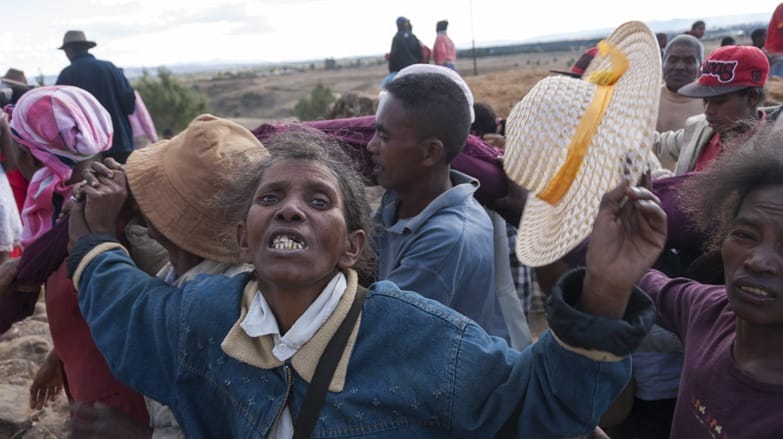
We set off bright and early on a Sunday morning from Antsirabe with our guide Lanto and Leonard, the pousse-pousse driver who knew the way. He was a wiry man, all sinew and muscles, thanks to a life pulling pousse-pousses around the streets of the city.
We drove north for about an hour then turned off into a field and kept going for a few more kilometers, following vague tracks, that eventually petered down to nothing at all.

On foot, we followed dozens of people, crossing rice paddies and climbing hills to the family tomb. Famadihana is a very important tradition in Madagascar. It only takes place every five to seven years; the right date is set by the tromba, the family shaman. The whole extended family attends; we saw hundreds of people from all walks of life, well-dressed women and bedraggled, barefoot children covered in snot.
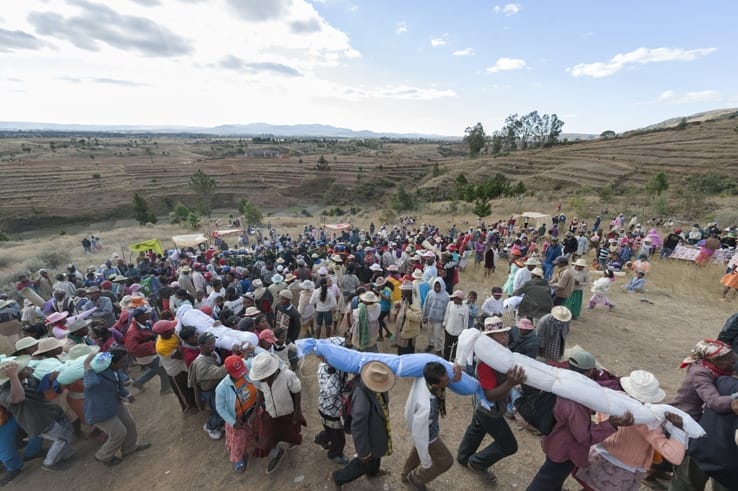
Our guide told us that not taking part in your family’s famadihana is considered serious lack of respect. You may be ostracised, and even worse, there will be no room for you in the family tomb. I noticed a single mother with four children, one of them still a baby. Elderly people, eyes cloudy with cataract. Many of them had probably taken out loans from moneylenders, to be there on that day.
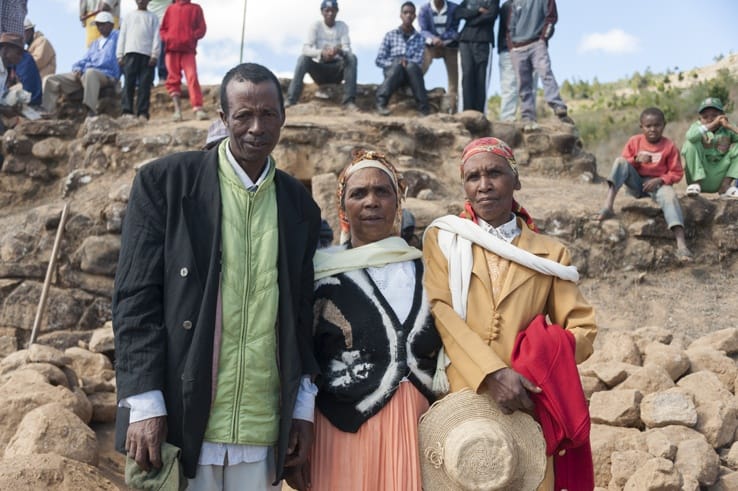
Entering the grave
The atmosphere around the tomb was festive and joyous. A brass band played Malagasy and international tunes, the crowd danced around waving rolled-up straw mats and drinking rum traditionnel. Some men dug around the grave entrance, placing mounds of dirt all around it. The tomb was about to be opened. Famadihana was about to begin.
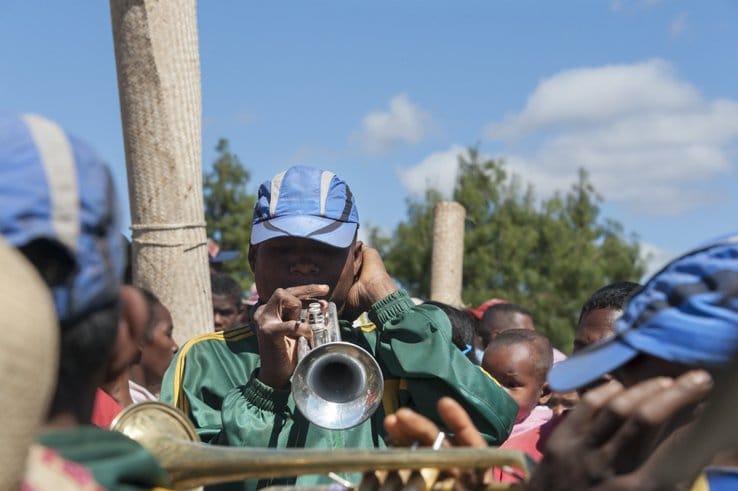
All of a sudden, I felt someone pulling on my arm. Suivez-moi, a woman said. Follow me.
I hesitated. Part of me wanted to enter the tomb. Part of me was terrified to do so. My curiosity won, and I tentatively stepped into the grave. The walls were carved with leaves and flower patterns. A narrow staircase led me to the upper level, where about two dozen corpses were piled, wrapped in musty shrouds.
There was a peculiar smell. It was sweet, but rancid. Earthy, but rotten. The smell of death, of decayed flesh. Nothing, nothing in that place was reminiscent of life. No wonder the dead wanted to leave for a while.
I ran out as fast as I could, and filled my lungs with fresh air.

Famadihana Celebrations
One by one, the dead were brought out of the tomb. The band kept playing, people dancing around them. First, I climbed on top of the tomb to get a bird’s eye view of the scene. Below, a colourful crowd circled the tomb, carrying the dead on top, wrapped in straw mats, before placing them in the sun. I didn’t want to intrude, to get too close to where the dead were lying. It’s not my place, I’m not family, I thought.
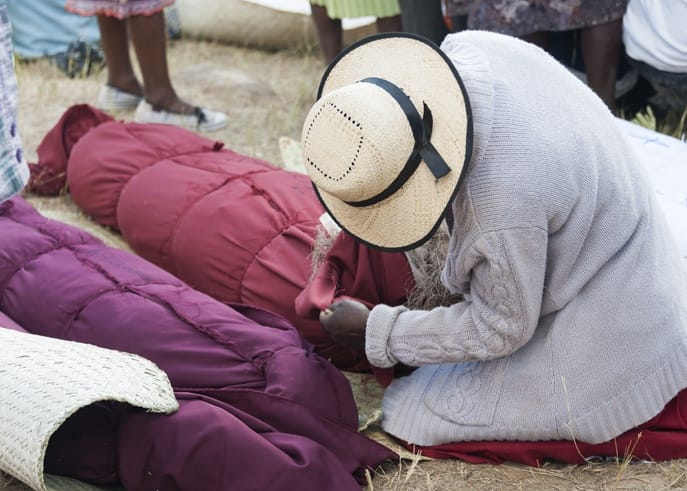
But again, my curiosity prevailed. I tiptoed towards the dead, and was immediately welcomed to the front. I expected tears, screams, despair. Yes, a few people were indeed crying. A young men unwrapped each shroud and kissed the corpses’ faces, before wrapping them again in a clean one and writing their name with a felt-tip pen.
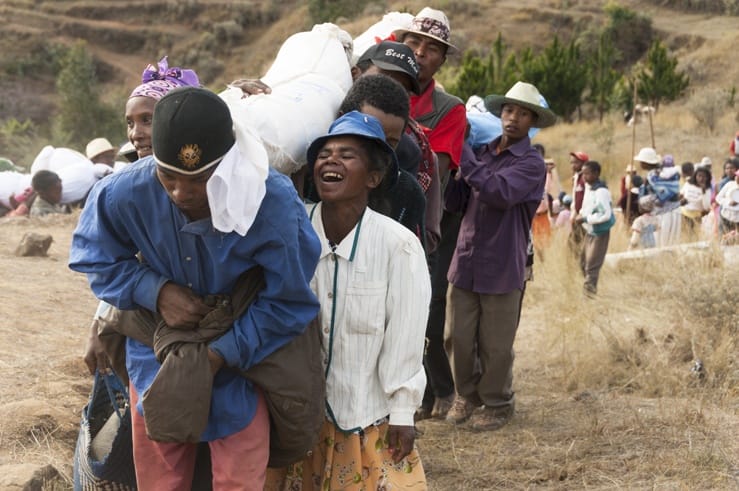
Each of the dead was given a gift. A bottle of perfume was emptied on top of Jeanne, who loved make-up and looking beautiful. Marie-Louise liked beer, and so a young man doused her with a bottle of THB. Lama was sprinkled with rum traditionnel.
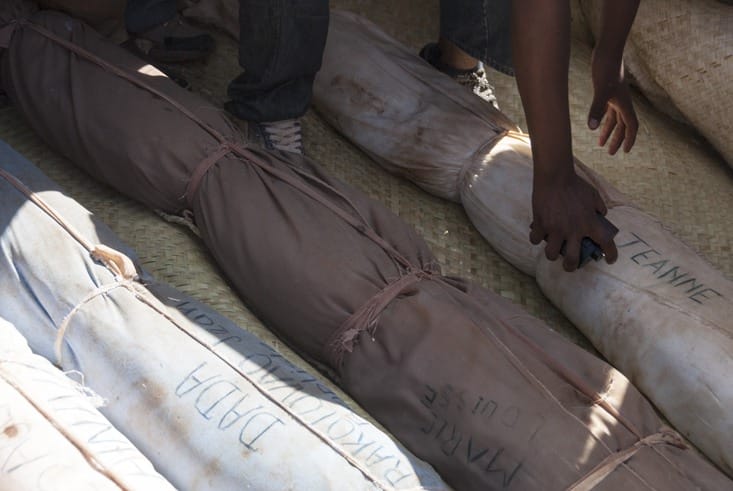
Then, everything happened so fast. My memories are confused, a whirlwind of colours, smells and music. The whiff of rum traditionnel on a man’s breath. A toothless woman wanting me to photograph her. A corpse wrapped in a shroud, laid on the side. Much smaller than the others, the corpse of a baby. People dancing, circling the tomb with the dead held aloft, making them dance.
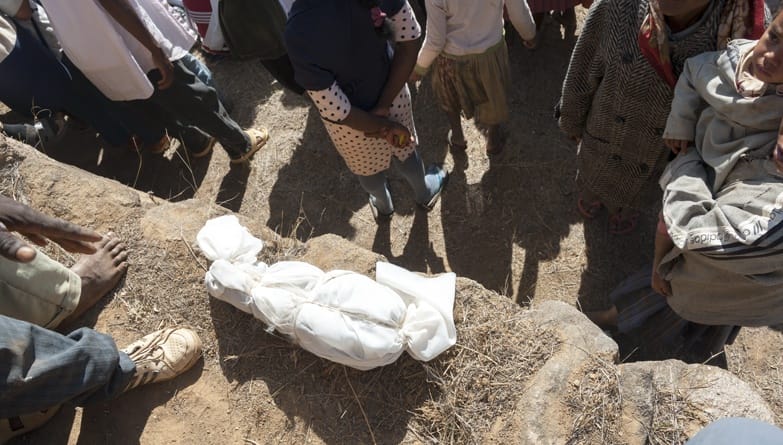
I remember walking back downhill, over hills and across rice paddies, as the tomb was being sealed again. Until next time.

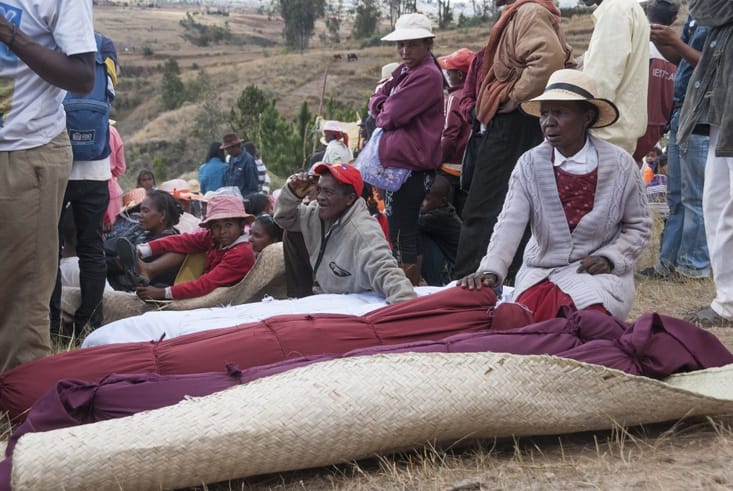
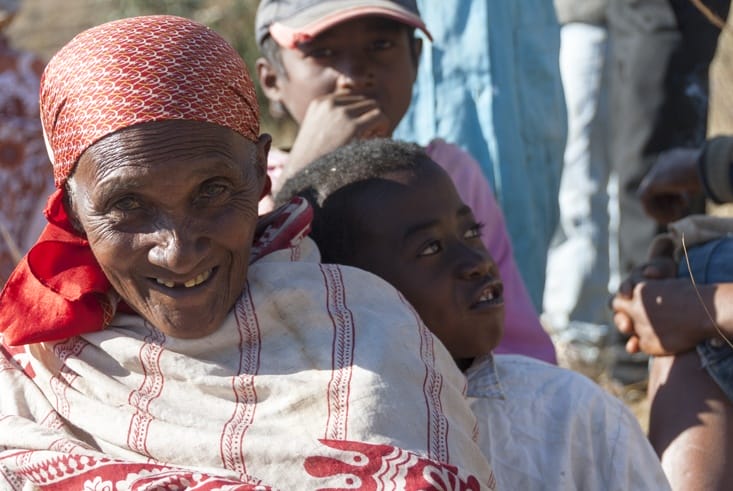
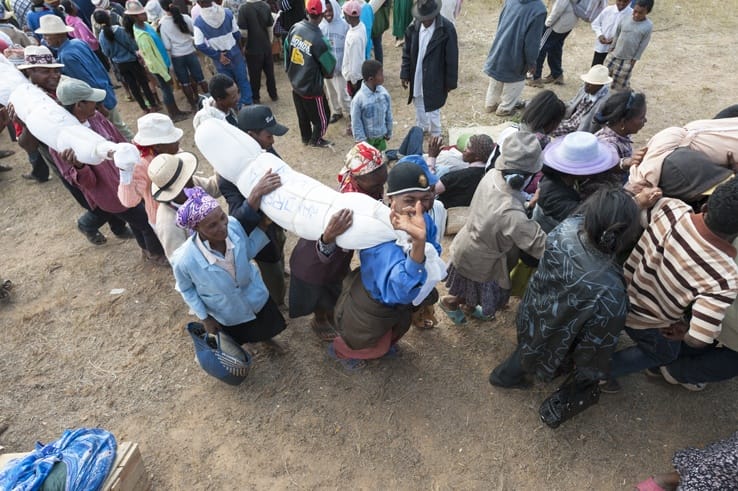

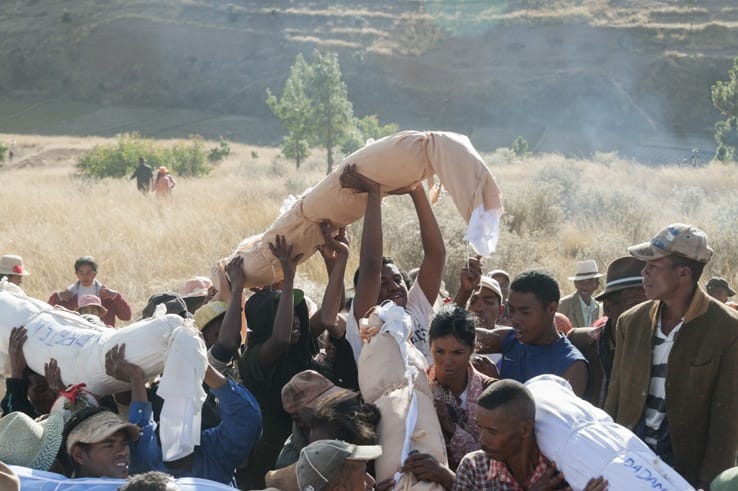
We would like to thank Lanto and Jimmy of Madagascar Tropic Voyage, without whom our famadihana experience wouldn’t have been possible.

That must have been an intense experience! Madagascar is high on my list. I am actually taking part in a dance performance here in Finland, and the teacher is from Madagascar. We dance to the rhytms of that island. He has also shown us a video of this ceremony. An interesting way of dealing with death.
Wow, this would have been a fascinating experience – I can understand how it would have been overwhelming, but what a worthwhile experience to have. Such a fantastic way to truly immerse yourself into their culture – I love all of your photos – really captures the celebration.
Thanks!
WOW. What an extraordinary experience – thank you for sharing it! It is difficult to imagine that joy and celebration if you haven’t experienced it. Your article is both sensitive and beautiful.
I was really shocked to read that the bodies are unwrapped and their faces kissed. Are they not too decomposed?
Many celebrations of the dead exist around the world and it’s quite fascinating to read about huge cultural differences like these.
A sentence says it all: “Joy prevailed over sorrow”. And I can honestly feel it through your words and photos. It must have been a moving and impressive experience.
I have to admit I’m jealous for how they deal with death. I wish I was raised in Madagascar to feel like they do in these situations!
This is an incredible experience and ritual to witness that definitely doesn’t happen every day and everywhere, it’s overwhelming for sure, but definitely worth it!
Oh gosh, this is fascinating experience. I think for something so sensitive you’ve done a great job is being respectful while telling the story.
I had never heared of this before. Your story and pictures are fascinating altough I don’t think this would be somewhere I would want to visit.
Wow, this is really fascinating! Talk about the perfect post for Halloween…
I honestly don’t know if I could stomach this festival. But I’m glad I read your post about it, because I think this tradition is so interesting. Your words and photos have captured the celebration so beautifully. What an experience!
The closest I have come to this was in Nepal and that was a moving experience. Great article and your photos are brilliant capturing the expressions of those personally affected.
Wow, I don’t even have words of how beautiful this ceremony was. You truly saw their culture on such a day as Halloween.
Absolutely fascinating look at the way different cultures look and deal with death.
Wow, what an interesting tradition! I’d love to visit Madagascar to witness this someday.
I’m kind of speechless…. and terrified! I literally have no words for this, it’s the strangest custom I’ve ever heard about for sure.
Wow, this is fascinating! I’ve never heard of this before. It must have been amazing to be offered such an intimate glimpse into a family’s tradition. I love how it is more a celebration of life and death than one with negative emotions.
What an incredible ritual to witness and participate in. It really does show how differently the dead are treated around the world. I cannot imagine something like this happening where I live. So fascinating.
impressive … I wish I could believe that death is not the end but somehow, I can’t get my mind to believe that…
How special that you were able to experience this event! I’m not even sure how to put into words the way I felt while reading this. It seemed like it should be so sad, yet it was a celebration but also with grief present. It certainly is fascinating to learn about the ways other cultures mourn/celebrate their dearly beloved!
Thank you, and Merry Christmas! Glad you liked the post!
Oh wow! What an experience, one that I would think not many non-natives get to experience! So amazing, thanks for sharing.
Thanks Cindy! It was so amazing, one of the most intense and mysterious events I’ve had the chance to witness in my life. There were no tourists for miles, another reason why Madagascar is really worth visiting!
This post is gold. I like how you went there just to visit and witness a unique culture from Madagascar. It just proves that people there have love and devotion towards their family. Even in their graves.
Thanks Elle. It was a wonderful, intense experience!
I just realized I’ll have a chance to see it as I’m going in July – I’m really hoping to find it after reading your post 🙂